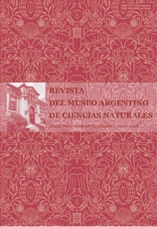Palinologia da Formação Irati (Permiano Inferior da Bacia do Paraná), em Montividiu, Goiás, Brasil
Resumen
Palynology of the Irati Formation (Lower Permian, Paraná Basin), from Montividiu, Goiás,
Brasil. The Irati Formation represents an important lithostratigraphic datum within the Permian of the Paraná
Basin, due to its stratigraphical distribution and varied fossil content. Among the fossil groups, sporomorphs
constitute the most efficient tool in providing a biostratigraphic refinement to the Upper Paleozoic sequence of
the basin. The taxonomic and biostratigraphic results from the palynological analysis of samples collected in an
outcrop in the «vale do rio da Serra», ca. 10 km at North of Montividiu, Goiás State (central-western portion of
Brazil), related to the Assistência Member (upper Irati Formation) are presented. The analysis revealed a
diversified microflora, especially rich in bisaccate taeniate and non-taeniate and polyplicate pollen grains; spores
and monosaccate pollen grains are rare. Qualitatively, the main genera are Alisporites Daugherty emend.
Jansonius, Limitisporites Leschik emend. Klauss, Protohaploxypinus Samoilovich emend. Morbey,
Striatopodocarpites Zoricheva & Sedova ex Sedova emend. Hart, Striatoabieites Zoricheva & Sedova ex Sedova
emend. Hart, Lueckisporites Potonié & Klauss emend. Klauss, Lunatisporites Leschik emend. Scheuring,
Weylandites Bharadwaj & Srivastava and Marsupipollenites Balme & Hennely emend. Balme. The assemblage
is related to the Lueckisporites virkkiae Interval Zone. Based on previous geochronologic data, as well as on
palynological correlation, an Artinskian age is proposed to the Irati Formation.
Brasil. The Irati Formation represents an important lithostratigraphic datum within the Permian of the Paraná
Basin, due to its stratigraphical distribution and varied fossil content. Among the fossil groups, sporomorphs
constitute the most efficient tool in providing a biostratigraphic refinement to the Upper Paleozoic sequence of
the basin. The taxonomic and biostratigraphic results from the palynological analysis of samples collected in an
outcrop in the «vale do rio da Serra», ca. 10 km at North of Montividiu, Goiás State (central-western portion of
Brazil), related to the Assistência Member (upper Irati Formation) are presented. The analysis revealed a
diversified microflora, especially rich in bisaccate taeniate and non-taeniate and polyplicate pollen grains; spores
and monosaccate pollen grains are rare. Qualitatively, the main genera are Alisporites Daugherty emend.
Jansonius, Limitisporites Leschik emend. Klauss, Protohaploxypinus Samoilovich emend. Morbey,
Striatopodocarpites Zoricheva & Sedova ex Sedova emend. Hart, Striatoabieites Zoricheva & Sedova ex Sedova
emend. Hart, Lueckisporites Potonié & Klauss emend. Klauss, Lunatisporites Leschik emend. Scheuring,
Weylandites Bharadwaj & Srivastava and Marsupipollenites Balme & Hennely emend. Balme. The assemblage
is related to the Lueckisporites virkkiae Interval Zone. Based on previous geochronologic data, as well as on
palynological correlation, an Artinskian age is proposed to the Irati Formation.
Texto completo:
PDFEnlaces refback
- No hay ningún enlace refback.

This work is licensed under a Creative Commons Attribution 3.0 License.

